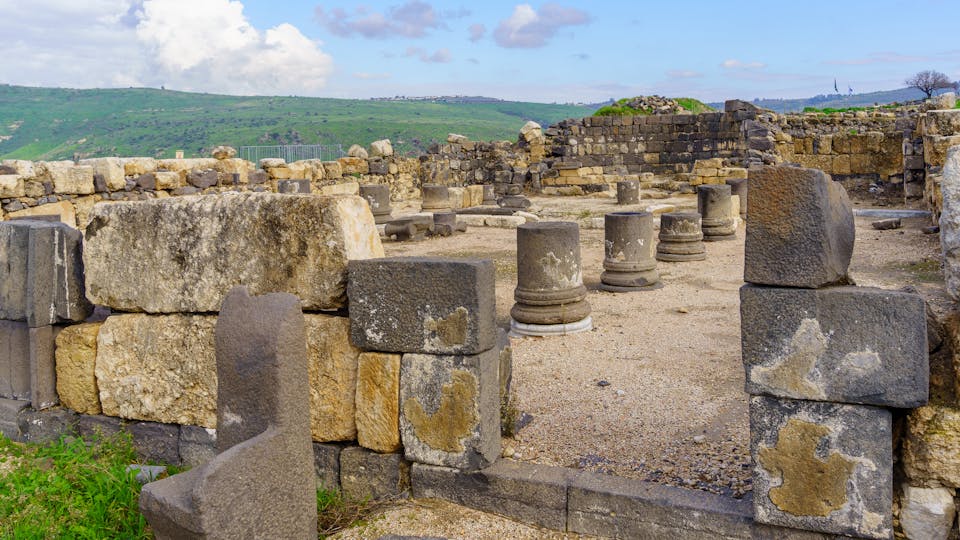Discover the Wonders of Sussita (Hippos) National Park

Sussita National Park is a must-visit destination for history enthusiasts and nature lovers alike. Nestled on a hill on the western slopes of the Golan Heights, the park offers breathtaking views of the Sea of Galilee and preserves the magnificent remains of the ancient city of Hippos, also known as Sussita.
A Glimpse into History

Sussita, meaning “horse” in Hebrew, reached its zenith during the Roman–Byzantine period before being destroyed by a major earthquake in 749 AD. Visitors can marvel at the impressive archaeological remains, including a forum, a vast water cistern, a grand basilica, and a small, roofed theater.
The forum, the main city square, was the hub of social, cultural, and commercial life. Surrounded by columned walkways with shaded spaces, it was a bustling center of activity. The ancient inhabitants cleverly built an aqueduct stretching 24 km to bring precious water to the city, with an underground pipe running beneath the main street.
The sophisticated cistern is remarkably well-preserved, allowing visitors to descend into its interior, which is still roofed with an impressive limestone arch.
Architectural Marvels

Next to the Forum stands the basilica, an impressive structure measuring 30 x 55 meters, built of dressed stones. It served as the center of activities during inclement weather. The Central Bathhouse, a notable public complex, includes the bathhouse itself and a spacious open courtyard. Nearby, the Odeon, a theater-like roofed structure, hosted cultural events like poetry readings with musical accompaniment, highlighting the population’s affinity for classical culture.
Eight churches, built after the fifth century AD, are scattered throughout the city. These houses of worship served the Christian inhabitants until the city's destruction by the earthquake in 749 AD.
Modern Historical Significance
Sussita also played a significant role in Israel’s modern history. During the War of Independence (1948-1949), the Syrian military outpost located there (which harassed Israeli communities below) was conquered by members of the neighboring Ein-Gev Kibbutz.
An IDF position was established next to the ancient town, using the controlling view of the surroundings to their advantage. A cable car, built in 1948 by Lt. Col. David Laskov, can still be seen today. It was used to ferry equipment from Ein-Gev to the Israeli soldiers stationed on the mountain.
Visitors can explore the remains of communications trenches, firing positions, and other features of the IDF outpost at the site.
Weather at Sussita National Park
The weather in the Golan Heights region can vary. Summers are typically hot and dry, while winters are cooler and can be rainy. Spring and autumn are generally mild and pleasant, making them ideal times to visit.
Best Time to Visit Sussita National Park
The best time to visit Sussita National Park is during the spring (March to May) and autumn (September to November) when the weather is mild and comfortable for exploring the park's outdoor attractions.
Nearby Locations to Combine with Your Trip
Nearby locations that can be combined with a trip to Sussita National Park include:
- The Sea of Galilee: Enjoy water activities and scenic views.
- The ancient city of Tiberias: Explore historical and cultural sites.
- Capernaum: Visit the “Town of Jesus”
- The Mount of Beatitudes: Visit this serene, religiously significant site.
- Kaztrin Talmudic Village: This living history site will take you back to the lives of the small Jewish community who lived and worshiped here 1600 years ago.
- Ein Gev Kibbutz: Experience the local culture and hospitality.
Frequently Asked Questions
What are the main attractions at Sussita National Park?
- Visitors can explore the ancient city's impressive archaeological remains, including the forum, a large water cistern, a grand basilica, and a small roofed theater. The park also offers stunning views of the Sea of Galilee and historical sites related to Israel’s modern history.
How do I get to Sussita National Park?
- The park is located on the western slopes of the Golan Heights, overlooking the Sea of Galilee. It is accessible by car, and visitors can follow signs from nearby towns and cities. It’s advisable to check local travel information for the best route.
What are the park's operating hours and entrance fees?
- The operating hours and entrance fees for Sussita National Park may vary, so it's recommended to check the official website or contact the park directly for the most up-to-date information.
Are guided tours available at Sussita National Park?
- Yes, guided tours are available and can enhance your visit by providing detailed historical and archaeological insights. Visitors can book tours through Sar-El Tours’ Operator or other local tour providers.
Plan Your Visit
Sussita National Park is not just a place of historical significance but also a site of stunning natural beauty. Contact your Sar-El Tours’ Operator to add an exciting visit to the Sussita National Park to your itinerary and immerse yourself in the rich history and breathtaking views of this remarkable location.